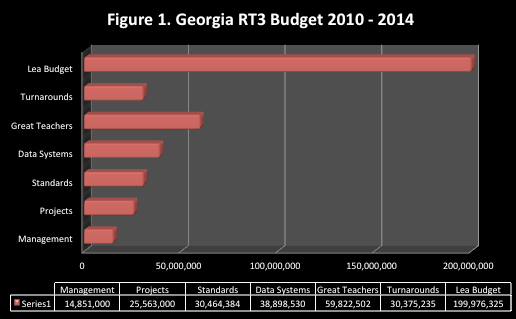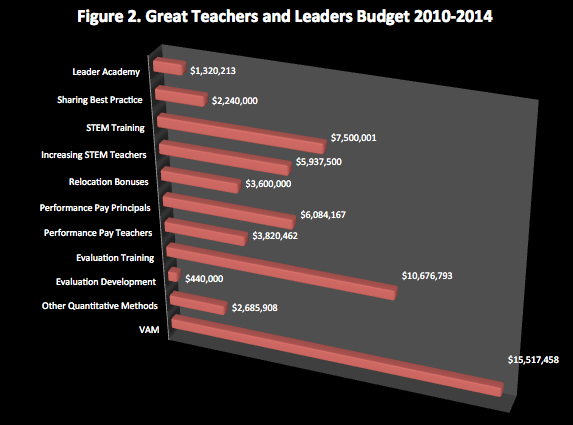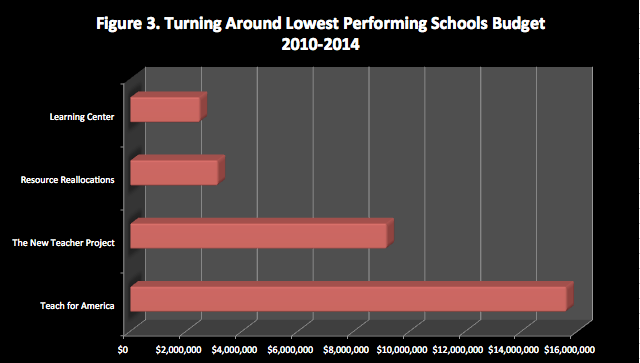In 2010 the Georgia Department of Education received ~$400 million from the Race to the Top (RT3) fund to Like all states that were winners in the Race to the Top (RT3) competition, Georgia’s scope of work entails four “project” areas:
- Standards and Rigorous Assessment–The grant proposal indicates that the state’s Common Core Georgia Performance Standards (CCGPS) in English/language arts (ELA) and mathematics for grades K-12 are aligned with the Common Core State Standards (CCSS). The state will develop “high quality” assessments aligned with the CCGPS and presumably the CCSS.
- Data Systems–Develop a warehouse of data integrating P-20 Statewide Longitudinal Data System (SLDS)
- Great Teachers and Leaders–make sure all students have effective teachers
- Turn Around the Lowest Achieving Schools–use data from high-stakes tests to name failing schools and either close them, or replace them with new administrators and teachers
How is the money that the state received distributed among the four project areas, and what does this tell us about reform in Georgia that is being propelled by the RT3.
Overall Distribution of Funds for Georgia RT3
As you look at the RT3 budget shown in Figure 1, half the of $400 million is distributed to the 26 school districts (LEA’s) to carry out the RT3 goals at the local level. LEA budget distribution is based their relative share of funding based on Title I, Part A of the ESEA. The other half of the funding is controlled by the Georgia Department of Education. Figure 1 shows that two goals lead in the distribution of funds, namely, Great Teachers and Leaders ($59 million), and Data Systems ($39 million). Turning Around failing schools ($30 million) and implementing standards and developing assessments ($30 million), and the management of the RT3 ($14.5 million) round out the budget.
Great Teachers and Leaders
A significant part of the RT3 grant in Georgia focuses on Great Teachers and Leaders. But what is really going on here? Is the goal to really create an environment in Georgia leading to great teachers and leaders. Are there going to specialized professional development projects in which all teachers are invited to take part? Will teachers be encouraged to be creative and to make key decisions about curriculum and instruction? Or is there something else going on here?
Figure 2 tells a different story. Instead of developing great teachers and leaders, the major part of the funds in this category are being used to develop tools that will be used to evaluate teachers on the basis of student test scores. Note that more than $15 million is directed to develop a Value Added Model to score teachers based on the improvement of student test scores. Using VAM is an unscientific and unreliable method of evaluating teachers. Note also that there are three items in the budget related to pay for performance, which has been shown not to improve teacher effectiveness or student achievement. Yet, in Georgia, teachers will be targeted by these methods that do not have a supportive research base.
Turning Around the Lowest-Achieving Schools
The Race to Top Fund promotes the idea that the lowest achieving schools should be either closed, or “reformed” using one of various reform models. In these reform models, the principal is fired, and at least half the teachers are replaced. In all cases, the measurement to decide performance is high-stakes testing. More than 90% of “lowest-achieving schools” were reformed by initiating the Transformation Model where the principal was replaced. The Transformation Model also calls for increasing teacher and leader effectiveness, instituting comprehensive instructional reforms, increasing learning time, and providing flexibility.
Yet, when the RT3 budget for turning around the lowest achieving schools is examined, its Teach for America (TFA) and The New Teacher Project (TNTP) that receives the lion’s share of the money. TFA and TNTP offer a pipeline of inexperienced and non-licensed teachers, who are hired by school districts and then placed in the lowest performing schools. According to the RT3 work plan, the lowest achieving schools need more flexibility to presumably enrich the curriculum and use a diverse set of teaching strategies to help struggling students. Yet, based on the budget, most of the funds will be paid to two organizations that train people in five weeks to teach. How could beginning teachers be expected to carry out new curricula or use a range of teaching strategies? It doesn’t make sense, nor is it a sustainable solution for helping improve education.
If you follow the money in the Georgia Race to the Top Project, its clear that the corporate, test-based model of education is the basis for many of activities. Teachers in Georgia will be evaluated using VAM scores, TFA and TNTP will send cadets to teach, while experienced teachers will find themselves moved to the side, especially those who lost their jobs during the Great Recession.







0 Comments